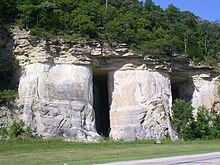Saint Peter Sandstone
| St. Peter Sandstone Stratigraphic range: Middle Ordovician |
|
|---|---|

Old mine entrances in the St. Peter Sandstone formation in Pacific, Missouri, where it is still actively quarried nearby.
|
|
| Type | Formation |
| Underlies | Glenwood Shale |
| Overlies | unconformity |
| Location | |
| Region | Midwest |
| Country | United States |
| Paleozoic Stratigraphy of the Upper Midwest, USA Dates are approximate, and deposition occurred at slightly different times in different areas |
|---|
|
Ordovician
:Maquoketa Group (446–440 Ma)
:Galena Group (454–446 Ma)
:Knox Supergroup (ct'd)
|
The St. Peter Sandstone is an Ordovician formation in the Chazyan stage of the Champlainian series. This sandstone originated as a sheet of sand in clear, shallow water near the shore of a Paleozoic sea and consists of fine-to-medium-size, well-rounded quartz grains with frosted surfaces. The extent of the formation spans north-south from Minnesota to Arkansas and east-west from Illinois into Nebraska and South Dakota. The formation was named by Owen (1847) after the Minnesota River, then known as the St. Peter River. The type locality is at the confluence of the Mississippi and Minnesota Rivers near Fort Snelling, Minnesota. In eastern Missouri the stone consists of quartz sand that is 99.44% silica.
In Minnesota, the soft St. Peter Sandstone can be observed at the bluffs of the Mississippi River valley beneath a very thin layer of Glenwood Shale, which lies below a much thicker layer of Platteville limestone. Examples can be seen at Minnehaha Falls in Minneapolis, the bluffs from downtown to Mounds Park in Saint Paul, and Minneopa Falls near Mankato.
...
Wikipedia
